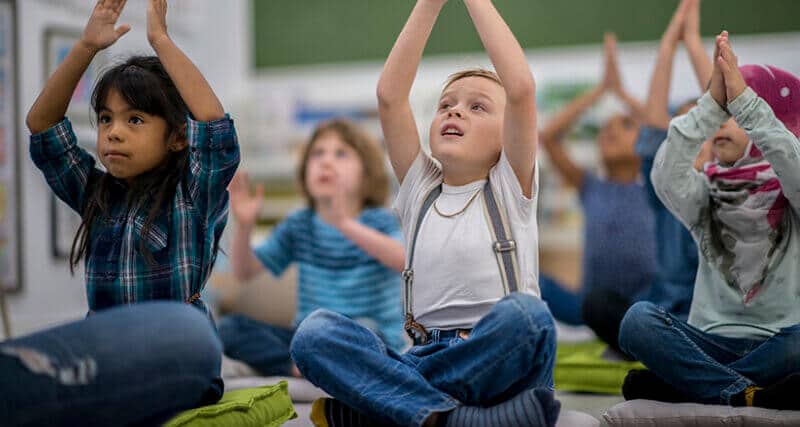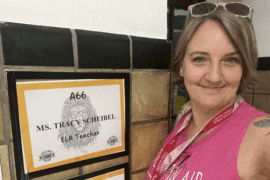5 Ways Classroom Yoga can Bring Effective S.E.L.
Let’s face it: schools are beginning to realize that Social and Emotional Learning (SEL) is a crucial missing piece in the classroom. Implementing this 3 letter buzzword– “S-E-L”– into daily routines, classroom culture, and school climate positively enhances the success of both students and staff.
In the state of New Jersey, the Department of Education supports SEL. The NJDOE defines SEL this way: “Social and emotional learning (SEL) refers to the process by which children and adults acquire and effectively apply the knowledge, attitudes and skills necessary to do the following: understand and manage emotions; set and achieve positive goals; feel and show empathy for others; and make responsible decisions. Students in SEL programs are more likely to attend school and receive better grades, and are less likely to have conduct problems. Successful infusion of SEL can result in positive behaviors, increased academic success, and caring communities.” With that being said, how do teachers find the time to implement SEL, among all the other lesson planning, SGOs, grading, and multiple other responsibilities and duties? One answer, I want to propose, is quite simple: yoga.
Why Yoga?
“Yoga?” you might ask: “how could striking curious, contorted poses achieve SEL outcomes?” Well, it’s time to expand our vision for what yoga can offer (and already is offering) to classroom teachers. Yoga goes beyond the stereotypical image of a “downward facing dog,” or bending your body into the shape of a pretzel. Yoga connects with your mind, body and breath. It creates connection within oneself and connection to others. Even more, it can be an ongoing practice of self-care. Moreover, as every good educator knows, when you reach the heart, you can teach the mind. When you align the mind with the heart, you can lead with love. The practice of Yoga has incredible potential to become a tool to support educators in the work of developing well-rounded student leaders who will make a difference beyond the classroom.
As a Youth Yoga Master Teacher, I have personally witnessed the profound impact that yoga has in the school setting. Over the past decade, I have taught thousands of students from pre-school to high school, including special education. I’ve created yoga programs that are specifically designed for staff and student success. I’ve seen how daily 5 minute Brain Breaks, weekly 30 minute sessions, or even an occasional school wide assembly promoting movement and mindfulness make big differences in student outcomes.
SEL and Improved Outcomes
The Collaborative for Social and Emotional Learning (CASEL) is a popular framework that many schools across the tri-state area are using for SEL. CASEL has brought focus to the fact that one of the biggest impacts SEL has on education is increasing academic achievement. As they point out, “According to a 2011 meta-analysis of 213 studies involving more than 270,000 students, those who participated in evidence-based SEL programs showed an 11% point gain in academic achievement.” Schools are realizing the value in SEL education, as future employers and companies are looking for employees that demonstrate skills beyond academic content knowledge: things like team building, thinking critically, and practicing empathy. Through the five core competencies in the widely used CASEL framework, students will develop SEL skills when teachers incorporate and model them as part of their daily curriculum, rather than seeing them as an additional task to accomplish.
CASEL’s Five Core Competencies align well with yoga and mindfulness practices. Together, yoga and mindfulness practices create a culture of “Kind-fulness:” being kind to yourself and to others. This “kind-fulness” mindset sets the tone for a productive and compassionate learning environment, where every person is successful.
Connecting Yoga to SEL Core Competencies
Here are five ways yoga is beneficial in the classroom when connected to these key competencies for SEL development.
- Self-Awareness:
Self-awareness begins with self-care. Yoga is a practice that supports learning healthy habits that create self-awareness for taking care of yourself physically and mentally. Starting with breath and breathing is a great tool to cultivate self care. No matter where you go, you always have your breath. Learning yogic breathing techniques helps to reduce anxiety and stress no matter how old your students are! When you are stressed out, your sympathetic nervous system (fight or flight) is working in overdrive. Taking a deep breath activates the parasympathetic nervous system (rest and digest) for your body to relax. Deep breathing sends a signal to the brain to allow the body to achieve calm.
- Self-Management:
Yoga supports self-management through a variety of sensory experiences. Learning yoga movement and mindfulness techniques assists with self regulation and managing emotions.
- Touch: Physical yoga postures help students create body awareness with movements.
- Hearing: Using yoga singing bowls or chimes is a way to support Mindful Listening. When students tune into their sounds, it helps to increase concentration and focus, which are important precursors to academic success. Since your brain is working when you are learning, you need to allow the brain to relax in order to soak up the material. When your brain can rest, you can do your best!
- Taste: Mindful eating is a tasty way to explore healthy habits with nutrition. It creates focus as we take in the sights, smells, textures, and flavors. It creates a present moment awareness experience through the activity of slowly chewing and thinking about how the piece of food got to your plate (respecting the farmers, the grocery store workers, the chef). It’s a thoughtful way to begin a conversation about making healthy choices.
- Sight: Balancing poses and midline movements helps to improve focus and concentration. When you keep your eyes focused on one object, it strengthens the brain in balancing poses. Midline movement (crossing right over left and left over right) support body awareness as it strengthens brain function.
- Scent: Using essential oils is a mindful way to create body awareness: using the nose. Essential oils can be used in a diffuser or experienced by smelling emptied essential oil bottles. The most kid friendly and safe oils to use in a classroom setting are lavender (calm), peppermint (focus) and lemon (immunity). Essential oils are natural “Plant Positive Power!” The scents also regulate emotions and stress, contributing to body awareness.
- Social Awareness: By incorporating yoga in the classroom with movement and mindfulness techniques, we naturally promote empathy and kindness. Yoga teaches students about respect. It builds classroom community and expands the knowledge of topics outside the school, such as the environment, social justice, and ethics. This social awareness can help to reduce bullying, promote better choices when it comes to social decisions such as smoking or drugs, and expand the appreciation of diversity.
- Relationship Skills:
Yoga enhances relationship skills in a variety of ways from team building activities with partner and group yoga and learning how to peacefully and constructively negotiate conflict by tuning into our feelings. You need to feel to heal. Acknowledging emotions is a stepping stone for successful interactions among peers. Also “heARTwork” activities such as journal reflections and coloring for calm are creative ways to create connection and community among peers. Yoga teaches us the importance of having a healthy relationship from within, so we can peacefully interact with others.
5: Responsible Decision Making:
Yoga and Mindfulness practices increase strength, flexibility and balance both physical and mental. Through movement, breathing techniques, relaxation tools, music and art, it enhances student memory, problem solving and critical thinking skills to make responsible and healthy choices. It’s an empowering practice that increases confidence and self-esteem. It creates a growth mindset and enables students to set goals and achieve them.
While these competencies are important for students, they are just as important for the teacher. Studies have shown that the connection between positive teacher and student relationships in the classroom setting are connected to academic achievement. How can you, the educator, practice self-care so you are functioning at your peak for your students? It’s just as important to recharge our own inner batteries. I like to remind teachers that self-care isn’t selfish. Self-care is “saying no to you, and yes to me.” Health is the most precious kind of wealth. A healthy mind and body is the key to being successful in just about anything.
- Amy Zambrano (See the Teachers’ Lounge interview of Amy here.)
Amy Zambrano is a leading Jersey Shore Youth Yoga Master teacher, sharing yoga movement and mindfulness in schools to support students and teachers for academic success, social emotional learning, and personal growth. Over the past decade, Amy has taught thousands of children and adults with her classroom yoga programs, yoga coaching for youth athletes, yoga summer camps, professional development workshops, and school assemblies. She has been featured in the “NY Yoga + Life” magazine for pioneering her yoga programs in education and has been a guest blogger for the yoga company, K-Deer. Amy is passionate about sharing her love of yoga to leave a positive impact on all she meets. Please visit: www.amyzambranoyoga.com for more information or follow her on Instagram and Twitter for inspiration: @amyzambranoyoga





